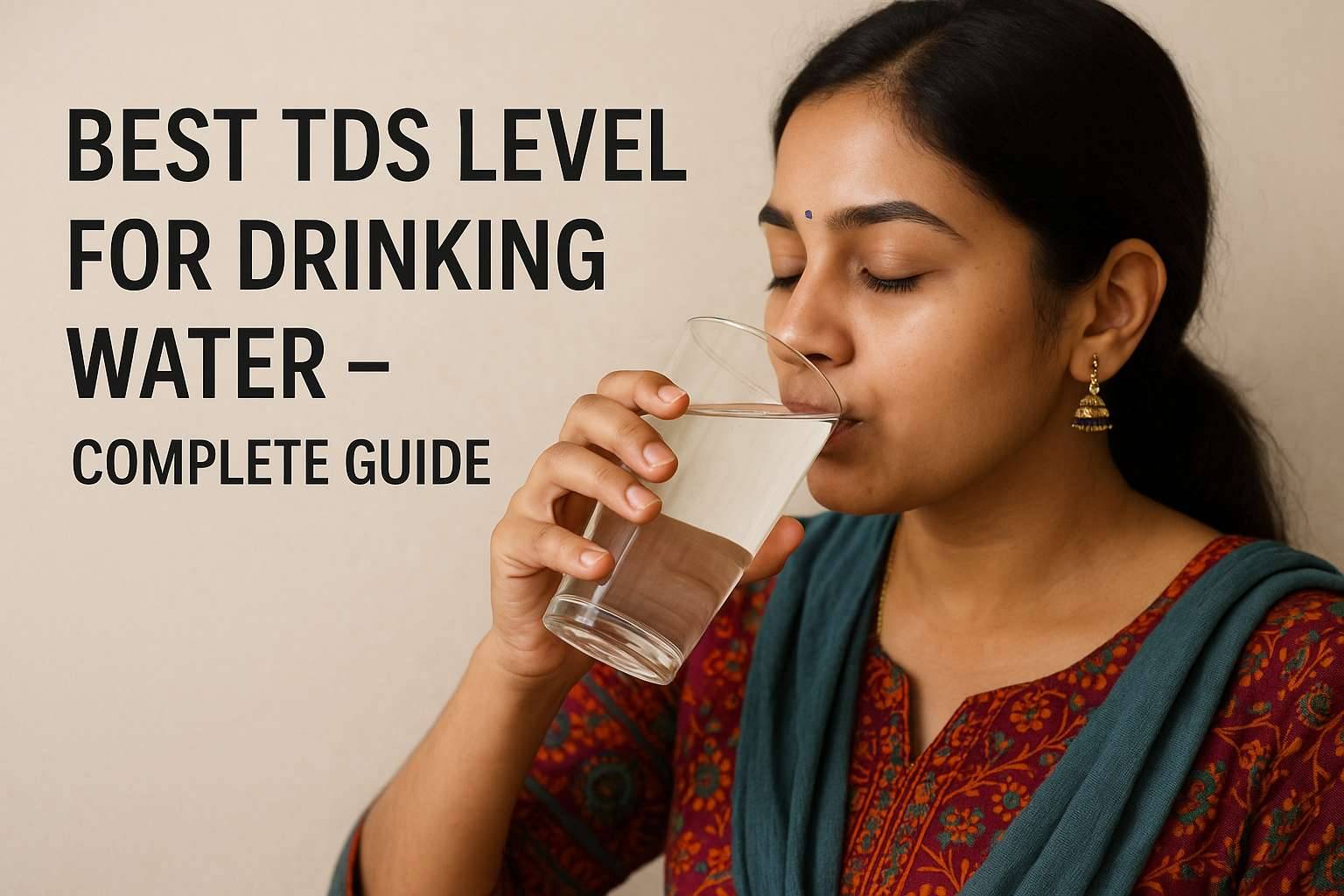Introduction
Have you ever measured the TDS of your drinking water and wondered whether it’s safe for your health? The best TDS level for drinking water has always been a subject of debate, especially in India, where water sources vary widely in quality. TDS, or Total Dissolved Solids, represents the concentration of minerals, salts, and organic matter in water. While some amount of TDS is essential for taste and nutrition, too high or too low levels can affect both safety and palatability.
In this blog, we will explain the best TDS level for drinking water in India, why it matters, how to measure it with a TDS meter, and what role RO purifiers play in maintaining healthy water quality.
What Does TDS Mean in Drinking Water?
TDS stands for Total Dissolved Solids. It refers to the combined content of minerals, salts, and other dissolved substances in water. These include calcium, magnesium, sodium, potassium, bicarbonates, chlorides, and sulfates. A moderate amount of these minerals is beneficial for health, as they contribute to hydration, bone strength, and electrolyte balance.
However, very high TDS levels can make water salty, bitter, or even unsafe for drinking. On the other hand, extremely low TDS, often seen in RO-purified water, may strip away essential minerals, making water tasteless and less nutritious.
Best TDS Level for Drinking Water in India
According to the Bureau of Indian Standards (BIS), the acceptable drinking water TDS limit is up to 500 mg/L. Water with TDS below this range is generally considered safe. However, the best TDS level for drinking water in India is typically between 50 mg/L and 150 mg/L, as this range ensures the right balance of taste, safety, and mineral content.
For comparison, packaged water brands such as Bisleri water TDS level are maintained around 120 mg/L, which falls within the ideal range. This ensures water is both refreshing in taste and safe for long-term consumption.
RO Water and TDS Levels
Reverse Osmosis (RO) is one of the most popular water purification technologies in India. An RO purifier works by reducing TDS levels, but it may sometimes lower them too much. For example, the RO water TDS level chart shows that untreated groundwater may have TDS of 500–2000 mg/L, but after RO treatment, it may drop below 50 mg/L.
While such low TDS water is microbiologically safe, it may lack essential minerals. That’s why many modern RO systems come with TDS controllers or mineralizers that retain or add back healthy minerals, keeping TDS within the best range for drinking.
Is Very Low TDS Water Safe?
Many people wonder, “Is 25 TDS safe for drinking water?” While water with TDS of 25 mg/L is technically safe from a microbiological perspective, it is not considered ideal for daily consumption. Such low TDS water lacks important minerals like calcium and magnesium, which are essential for bone and heart health.
Experts recommend that the minimum TDS for drinking water should be at least 50 mg/L, as anything below that may taste flat and deprive the body of natural minerals.
How to Measure TDS at Home
Measuring the TDS of your water is simple with a TDS meter. This handheld device quickly measures dissolved solids in parts per million (ppm). All you need to do is dip the probe into a glass of water, and the reading will tell you the TDS level instantly. By regularly checking with a TDS meter, you can ensure your purifier is maintaining water within the recommended range.
Best TDS Level for Different Water Sources
The right TDS level often depends on the source of water. For example:
-
Groundwater: Often has high TDS due to dissolved salts and requires RO purification.
-
Municipal water supply: Usually falls within acceptable TDS range but may need filtration for taste improvement.
-
Packaged water: Brands like Bisleri maintain TDS levels around 120 ppm, which is considered optimal.
Thus, while the official drinking water TDS limit is 500 ppm, keeping your water between 50–150 ppm is ideal for both health and taste.
FAQs
Q1: How much TDS in water is good for drinking?
The best TDS level for drinking water is between 50–150 mg/L. This range ensures good taste, safety, and essential mineral content.
Q2: At what TDS level is RO required?
If your water has TDS above 300 mg/L, an RO purifier is recommended to reduce excess salts and make the water safe for consumption.
Q3: Is TDS below 50 good?
TDS below 50 mg/L is safe but not ideal. Such water lacks minerals and may taste flat. Experts recommend maintaining a minimum of 50 mg/L.
Q4: Is 200 TDS water good for you?
Yes, water with 200 mg/L TDS is safe and acceptable as per BIS standards. It may have a slightly salty taste but still provides essential minerals.
Conclusion
The best TDS level for drinking water plays a key role in ensuring safety, taste, and health benefits. While the BIS allows up to 500 mg/L, the optimal range is 50–150 mg/L, which balances mineral content and purity. Using a TDS meter helps you track your water quality, and choosing the right purifier ensures you never compromise on safe hydration. Whether it’s RO water TDS level for drinking, Bisleri water TDS level, or municipal supply, maintaining water within the right TDS range is the secret to healthier living.
Also Read -





